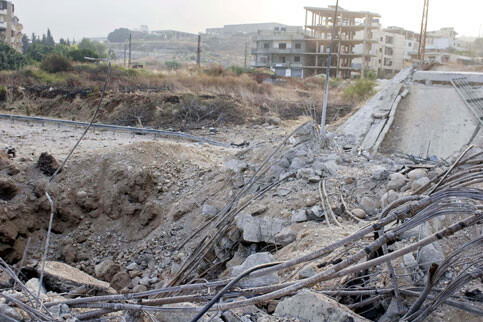United Nations High Commissioner for Refugees 23 July 2006

The coast road from Beirut to Khalde bombed by an Israeli air strike July 20, 2006. The Israel air strikes have destroyed much of the Lebanese infrastructure and transport network. (MaanImages/Raoul Kramer)
BEIRUT – Conditions for fleeing Lebanese seeking refuge in the mountain areas north of Beirut are precarious, with relief supplies needed urgently to cope with the growing numbers of displaced, says the top UN refugee agency official in Lebanon. The problem is getting those supplies into the country.
UNHCR teams are buying supplies such as mattresses locally for the time being, but are increasingly anxious for a safe delivery route into Lebanon so relief supplies can be delivered from outside. Tonnes of relief items were moved Friday and were en route to Damascus, Syria, on Saturday in a convoy from the agency’s stockpiles in Jordan.
“The tragedy is that the supplies are there in Syria. The question now is how to get them in? If the overland route is out for the time being, as it seems, we’ll have to move supplies in from Cyprus,” said UNHCR’s Geneva-based regional director Ekber Menemencioglu on Sunday.
On Friday night, 500 tents, 20,000 mattresses and 20,000 blankets were moved in convoy from Amman in Jordan to Damascus, awaiting the green light for a safe corridor into Lebanon. On Monday, another 25 trucks are scheduled to bring 4,000 tents, 5,000 plastic sheets, 5,000 kitchen sets, 5,000 stoves, 5,000 jerry cans for water, 5,000 jerry cans for kerosene and 5,000 lanterns plus other items from Amman to Damascus.
UNHCR is setting up a logistics base in Cyprus, but with the agency’s large Middle East stockpiles located in Jordan and Damascus, the land route from Syria to Beirut would be a much faster option. Supplies from the convoys this weekend will also be used to help Lebanese fleeing into Syria.
In the Aley region north of Beirut, there are over 38,000 displaced people living in schools out of a total displaced population of more than 80,000 displaced who have fled here. Those not accommodated in schools have found shelter with family and friends or are living independently.
“At the schools, people are traumatised and anxious. The conditions are very precarious,” said UNHCR’s top official in the country, Arafat Jamal, after a visit to the area on Saturday. “There’s a lot of overcrowding, with people sleeping three families to a room and tremendous pressure on the sanitation facilities,” he added.
Food stocks are running extremely low in the schools, he said. Overall, the response by the local authorities to the influx is professional, swift and coordinated, with school facilities being kept clean thanks to a disciplined and systematic cleaning rota put in place by the displaced.
In close collaboration with local authorities, UNHCR teams have been working in the mountain regions since early last week, assessing the situation and buying supplies, particularly of mattresses, to help ease the strain on those living in public buildings.
“It is vital to get a guaranteed humanitarian corridor to bring urgently needed supplies in here fast. It’s deeply frustrating having tonnes of relief supplies from our regional warehouses ready to come at a moment’s notice but not having a guaranteed safe route,” he added.
Meanwhile in Syria, there is a constant stream of displaced Lebanese flowing across the border, with 20 cars arriving every five minutes at one border crossing point. An estimated 12,000 people are arriving daily. UNHCR has mobile border monitoring teams at the most active border points of Al Aridha and Daboussia.
Most of the Lebanese arrivals are finding accommodation with friends and relatives, but some 700 families are living in communal shelters and are being assisted by the Syrian Red Cresent with help from UNHCR.
Related Links